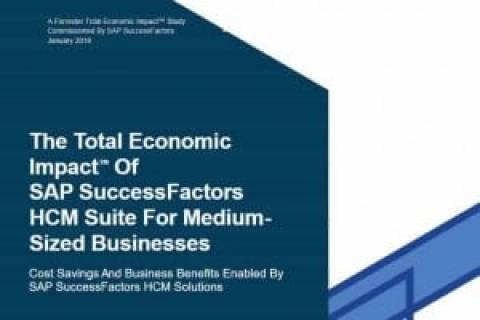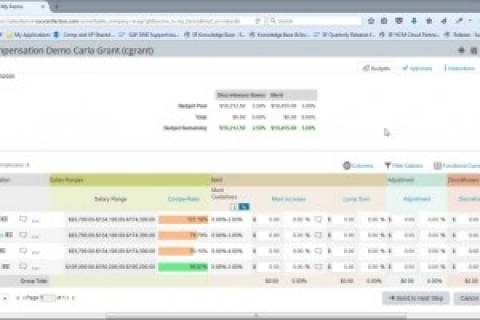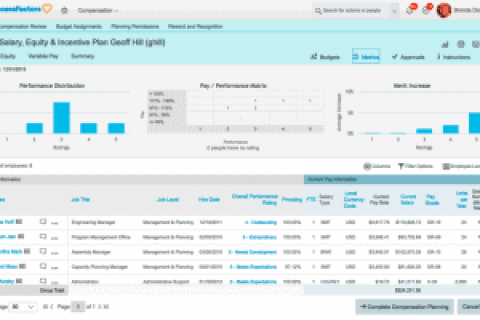An Organization’s Compensation strategy is crucial for achieving high Employee satisfaction and retention. But very rarely do employees understand or appreciate the value of their compensation package. Total compensation Management provides an overview across your remuneration schemes, giving Employees clarity on their Total Compensation package and Leaders can drive Company Performance in an agile manner.


Contents
Understanding the Impacts of poor Total Compensation Management Visibility
For many organizations, compensation data lives in multiple, disparate systems. This makes it difficult for employees, managers, and HR to access the data. Each stakeholder group is impacted in different ways:
- Employees
A lack of visibility makes it hard for employees to get a comprehensive view of their total compensation and understand how much the company values their contribution toward driving your organization’s success.
- Managers
The less visibility managers have into their team’s total compensation, the more challenging it becomes to motivate and coach individuals needing support. This can limit their potential to achieve team objectives and organizational goals.
- HR and Finance leaders
Poor compensation visibility makes it challenging for HR and finance leaders to identify pervasive issues across the organization or spot outliers that may indicate mistreatment or favoritism.
Addressing Changing Total Compensation Management Requirements
To help ensure that compensation management strategies remain effective and meet your organization’s needs, you should consider several factors.
- Alignment of Rewards with Organizational Goals
Increasingly, Companies are linking Employee Compensation with an Individual’s contribution to Company performance or team goals. Aligning Total Compensation with Corporate Goals has the power to pull in all departments and functions the same direction- of Company’s growth.

- Variable Pay to reward Performance & increased Pay Transparency
Leading organizations have found that offering Variable Pay effectively connects employees’ behavior and actions with Company, Team, and Individual performance. However, the way that Variable Pay (annual or quarterly bonuses or incentives to spot awards, project bonuses, team awards, commissions, and sales program incentive funds or “SPIFFs.”) is used has evolved. Also, offers Transparency to Employees when it comes to their Compensation.
- Restructuring of Pay for remote working & Digital Transformation
The COVID-19 pandemic accelerated digital transformation initiatives in several industries rapidly.Remote working has brought technology to the forefront and planning Compensation packages on spreadsheet-based solutions no longer work in a distributed work environment. There is no access to analytics providing insights into Compensation allocation and whether this aligns with targets with decentralized planning. To address this, it is critical to put in place agile, automated, and unified compensation solutions that can be accessed across your organization.

Managing a Complex Total Compensation Management Landscape
Each type of compensation serves a specific purpose. The way different organizations combine the compensation pillars varies drastically depending on Corporate goals and current Business conditions. Your Total Compensation Management solution should support the areas outlined on the following page.
Short-Term Incentives
Also called Annual incentives, short-term incentives are awards given within one year to an employee for helping the company achieve its short-term strategy or goals. These incentives align work with the company’s success while helping employees feel appreciated and keeping them motivated and performing at their best.
Short-term incentives may include:
- Recognition programs
These programs show employees your appreciation and acknowledgment for contributions to the Business that are linked to your Company’s purpose, mission, and values. Can be Peer-to-Peer, Manager-led, or Leadership-led recognition.
- Management-by-objectives (MBO) bonus
Paid Annually or Quarterly, these cash bonuses are linked to an Employee achieving specific Individual or Corporate objectives.
- Revenue-Based Incentives
Directly tied to the number of products or services that an employee sells, the success of your organization, or an achieved objective, revenue-based incentive compensation programs are delivered in a number of ways:
- Commissions
- Based on either a flat rate for every sale made or a tiered rate linked to the percentage of a target achieved.
- Sales incentives
- These involve a stated Compensation amount and are often in the form of a Bonus paid when an employee achieves a specified target such as fulfilling a sales quota.
Base-Salary Adjustment
Salary adjustments may take place throughout the year for a variety of reasons, such as a i) standard part of the Employee Appraisal process where a merit increase is awarded based on satisfactory Performance ii) Cost of Living increase, iii) Labor agreements.
Long-Term Incentives
With an extended time horizon (generally of more than one year), long-term incentives reward the achievement of long-term plans and promote buy-in to corporate objectives. Types of long- term incentives can include restricted stock units, stock options, and performance shares.
How can a Total Compensation Management approach benefit your Business?
Providing a unified view of all elements of Compensation, a Total Compensation Management approach delivers significant value to People in different roles across your Business.
Employees can clearly see how they’re valued by your organization with a centralized view of their Compensation package.
With in-depth insights into how Compensation impacts Performance, Managers can make decisions about how best to use different Compensation programs to motivate and retain top talent.
Finally, easy access to analytics on Customer, Market, and Territory data helps your organization set appropriate and realistic Sales Performance targets.


Creating a Total Compensation Management Infrastructure
A successful rollout of your Total Compensation Management strategy requires establishing a robust and comprehensive Technological infrastructure. Some points to consider are as follows,
Advanced, best practice-based functionality helps you streamline and automate compensation management tasks. Meanwhile, fast and intuitive self-services are crucial to help ensure that employees, managers, and HR and finance leaders can quickly and easily access information and gain the insights they need.
Flexibility is another important requirement for your total compensation management solution. In this way, you create a positive workplace culture that helps you attract – and keep – top talent, giving you a competitive edge in an uncertain business environment.
Recommended Resources
Get to know Compensation Management better!
Countries localization
Million Users
Delivered languages













